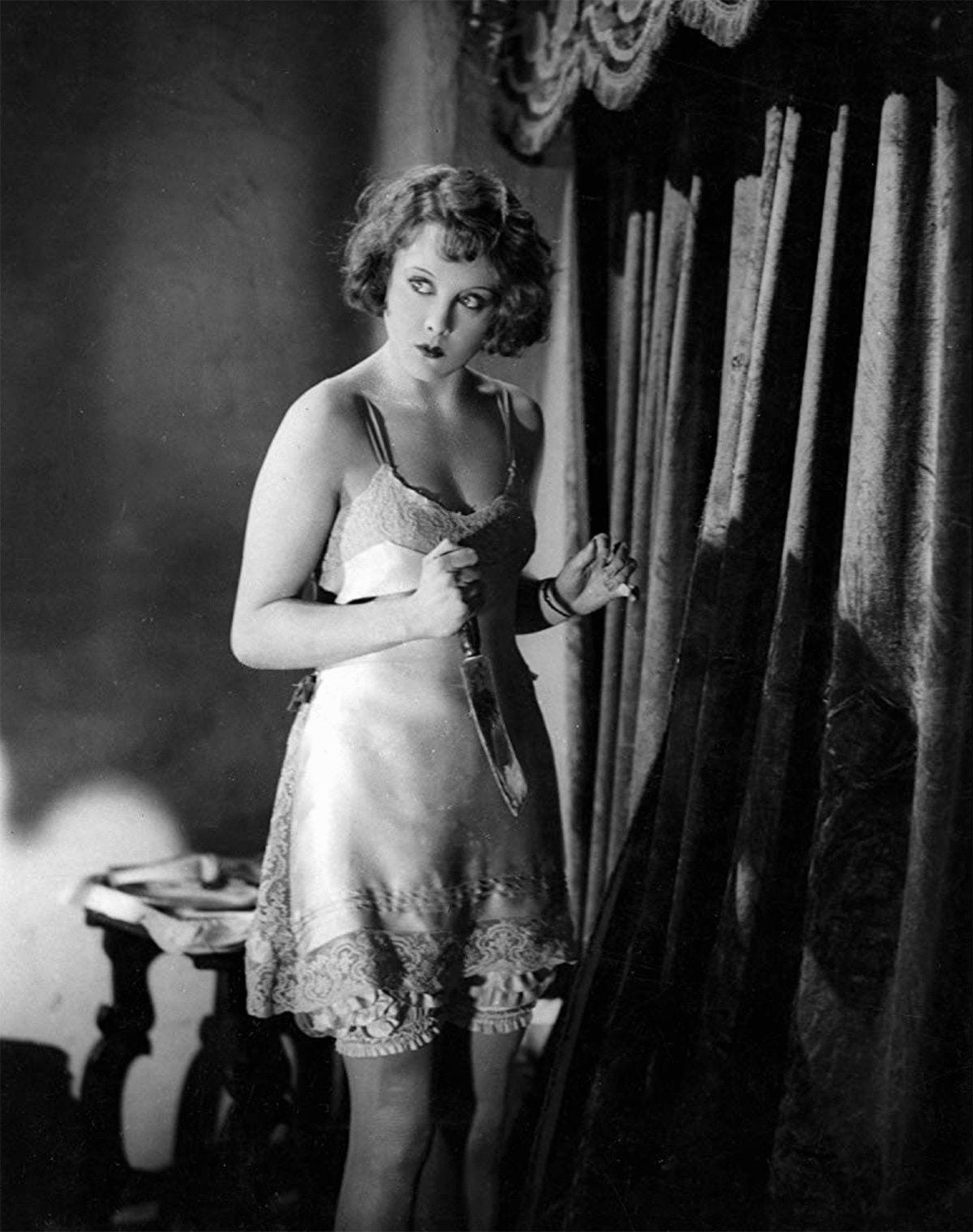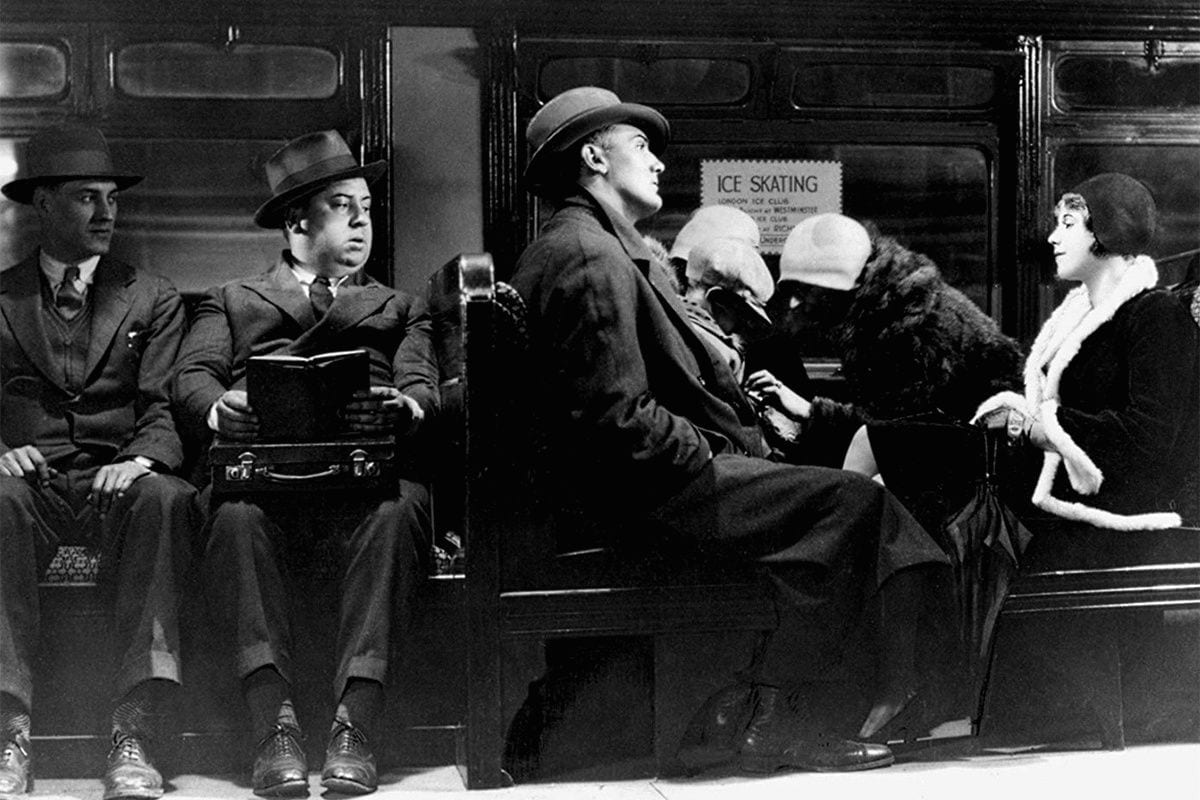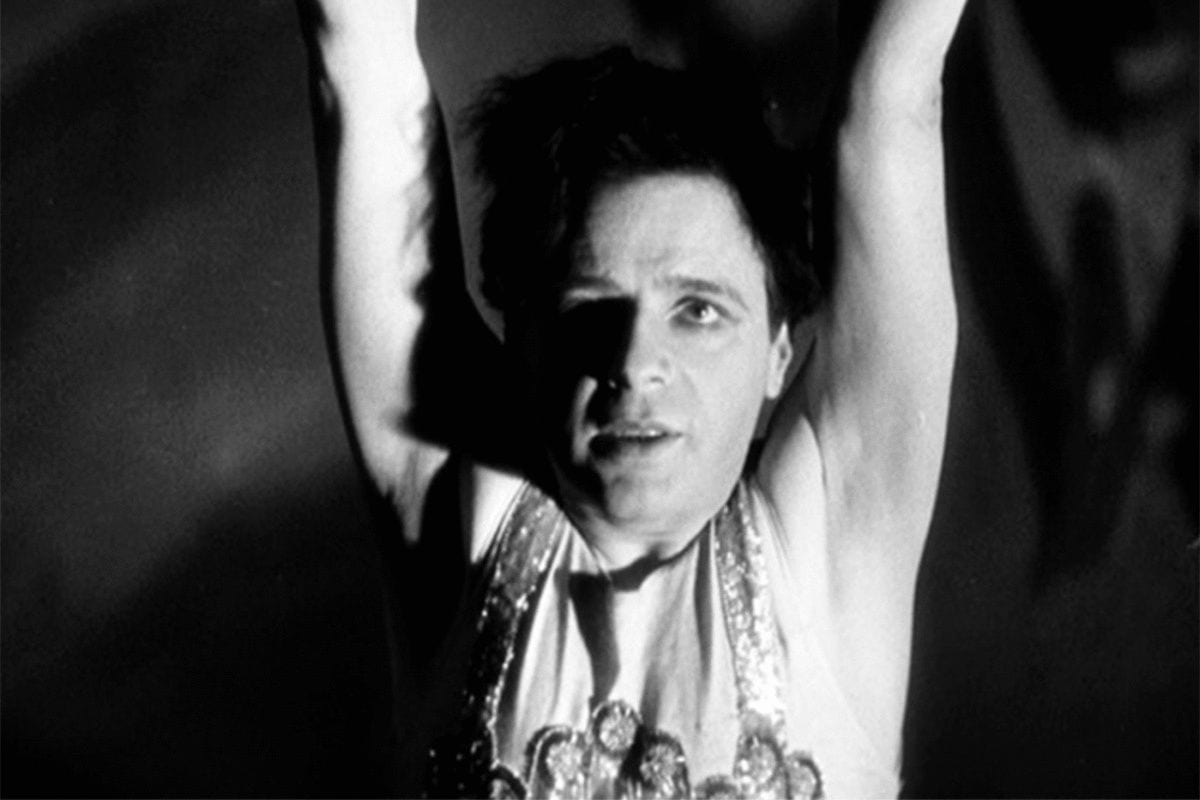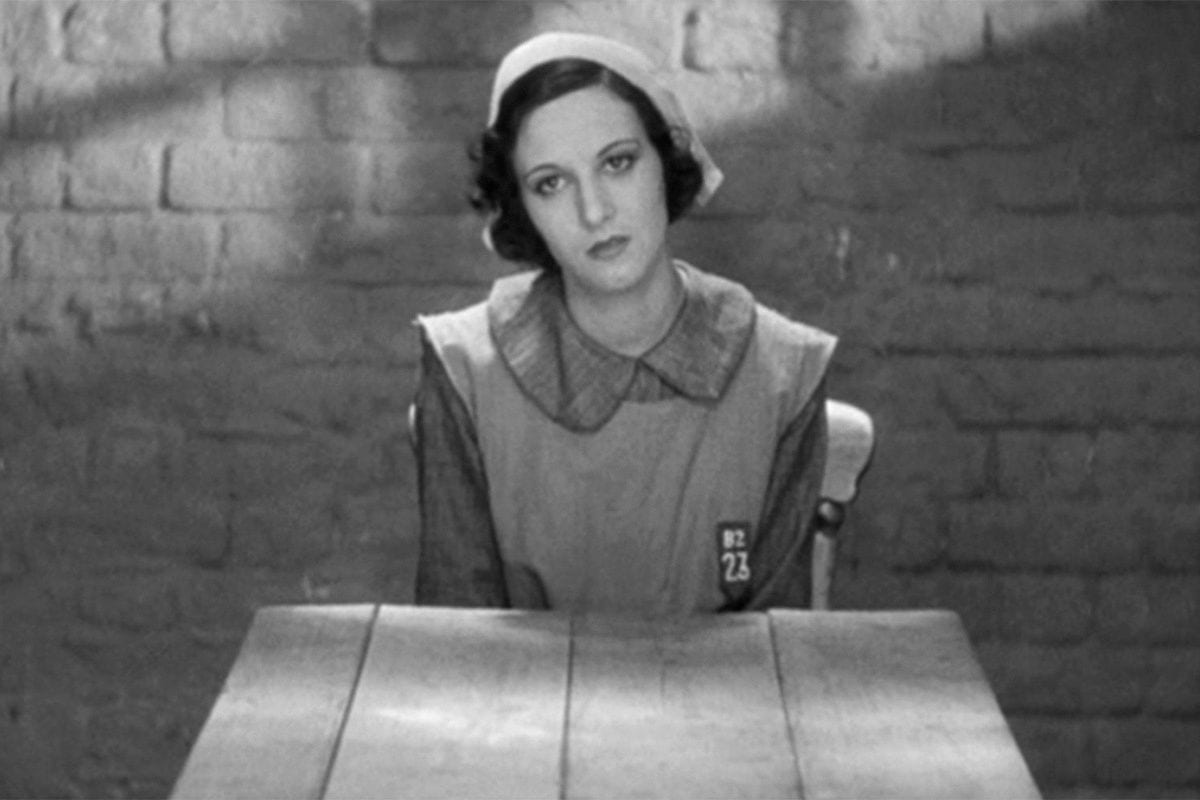

Alfred Hitchcock’s second and third suspense films, Blackmail (1929) and Murder! (1930), make attractive new Blu-rays from Kino Lorber. These thoughtfully constructed packages give viewers a chance to cram on two of the director’s formative thrillers and their lesser-known variations.
Blackmail’s Two-Timing Trick
Based on a play by Charles Bennett, which it apparently alters significantly, Blackmail constitutes the start of Bennett’s collaborative association with Hitchcock. The film was shot in both silent and sound versions, both carefully conceived, and advertised as the first British talkie. The silent version, which was playable in more theatres, got released shortly after the talkie’s premiere. The success of the talkie in film history supplanted the silent version so thoroughly that only the talkie circulated for decades; it was the only version on VHS, for example.
Thanks to the British Film Institute‘s mouth-watering, crystalline restoration of the silent film in 2012, we can see clearly that, for all intents and purposes, two films exist. It’s not a mere case of layering sound effects and music over a silent film, nor of reshooting a few passages of dialogue. Apart from the opening sequence, most of the film was shot twice, even dialogue-free shots that shouldn’t have required it, resulting in a film ten minutes longer than its silent counterpart. One way we can detect the re-use of silent footage in the sound version is that talkies ran through the projector at 24 frames a second, faster than silents, and therefore the talkie’s recycled silent passages appear speeded up, as seen in the lobby footage at the restaurant, for example. The vast majority of the film has no such speeded effect.
In both versions, the opening segment is largely the same footage emphasizing the speed of a police car, the idea of sound as communicated by visual hints like earphones, and the expressionist shadow-play of apprehending a thief in a boarding house and taking him down to the station for a day in the life of average Scotland Yard coppers. The story really begins when broad, square-jawed young Detective Frank Webber (John Longden) goes on an unsatisfactory date with his capricious yet pretentious working-class girlfriend, Alice White (Anny Ondra), whose parents run a little news-agents’ shop in Chelsea. Alice, with dreams of her own wonderland, two-times Frank by giving him the brush-off when a secret beau shows up, the artist Crewe (Cyril Ritchard). In other words, Alice is introduced to the viewer as a lying little minx.
In the silent version, she rather gamely dashes up to the artist’s apartment to look at his etchings, or at least his painting of a jester pointing at the viewer in mocking laughter, and she’s easily persuaded to try on a tutu. It’s virtually her idea. In the talkie, she’s much more hesitant on both counts and must be wheedled and flattered and jollied along by Crewe.
Smoke by werner22brigitte (Pixabay License / Pixabay)
In the silent, Alice goes into offscreen space, standing behind a screen, to change her clothes, and then the camera brazenly pans right to glimpse her in slip and stockings. In the talkie, the Chinese screen creates an artificial split-screen effect that puts her on the right side of the image while, on the left, Crewe plays the piano and sings. The silent version has no piano.
Both versions have Alice painting a cartoon face on a canvas while Crewe affixes a slender nude body. These paintings are slightly different, with the talkie’s version having an incomplete crotch. This creates mild continuity errors when the silent painting reappears later in the talkie.
In both versions, Crewe eventually throws himself at Alice and drags her to his curtained bedchamber. In the talkie, the sounds of her screaming amid the struggle are overlaid onto the window view of a policeman walking under the streetlight below. Alice’s earlier glimpse of him had reassured her that safety was near in case she needed to call for it. The ironic replay of this image, with the oblivious bobby passing by, foreshadows the moment in Hitchcock’s Frenzy (1972) demonstrating that from a London street it’s impossible to hear screams in an apartment.
In fact, many moments in this movie foreshadow later key moments in other Hitchcock films. The struggle behind the bed-curtain not only foreshadows the shower curtain in Psycho (1960). The close-up of Alice’s hand reaching blindly outside the curtain and grasping through the air, while the viewer sees a bread-knife in close proximity and wills for her to grab it, echoes a similar moment in Dial M for Murder (1954) when the audience wishes to place the scissors in Grace Kelly’s hand. In both cases, the audience’s bloody desires are granted, because above all it is the viewer who wants violence.
A hand for a hand. In the silent version, the sudden protrusion of Crewe’s lifeless hand is a masterfully shocking visual detail. In the talkie, we’re more absorbed, ironically, by the utter silence of the shell-shocked Alice emerging into view in her slip, the knife glinting under a key light that matches the mad brightness in her eyes.
Anny Ondra as Alice White in Blackmail (IMDB)
The rest of the plot involves the police investigation and the intrusion of a slimy blackmailer, Tracy (Donald Calthrop), into the lives of Alice and Frank. One intriguing unanswered question is why this blackmailer had been pestering Crewe. Did he have some goods on Crewe, thus implying that the artist was some kind of serial something-or-other?
In his commentary on the talkie, historian Tim Lucas takes us through many comparisons of the two versions and many references to Hitchcock’s other films. I’ve tried to avoid repeating them here in favor of contributing additional observations. For example, the talkie layers much canary singing onto one scene, perhaps in a reference to the slang for confessing to the police and perhaps partly to echo the use of whistling by various characters. When the blackmailer helps himself to breakfast at Alice’s house, he whistles “The Best Things in Life Are Free”.
The talkie is most famous for demonstrating Hitchcock’s awareness of sound as a plastic and expressive element, most notably in the scene where a gossipy neighbor’s rattling monologue becomes a subjective drone in Alice’s head with only the word “knife” repeating sharply and endlessly, as though stabbing her ears. This trick obviously isn’t employed in the silent version, yet that version still implies sound via a jarring close-up of the shop’s bell. The fact that Alice sits on opposite sides of the table in each version testifies to how carefully Hitchcock re-conceived the scenes.
Hitchcock had been implying sound effectively in silent films as early as The Lodger (1927), another film about a blonde heroine and her copper boyfriend. As in that film, he plays with the visual effect of a scream. In the talkie, what seems to be Alice’s scream is a transition to a jump-cut on a landlady’s scream.
Blackmail‘s other famous element is the chase climax inside the British Museum, where the contrast between “little” people and a monumental stone face foreshadows the Statue of Liberty in Saboteur (1942) and Mount Rushmore in North by Northwest (1959). Lucas reads from the memoir of assistant Michael Powell in which he takes credit for suggesting the museum. Perhaps Powell did contribute the museum idea, though Lucas points out that Hitchcock’s The Ring (1927) already uses Royal Albert Hall, which would be revisited in The Man Who Knew Too Much (1956), so Powell can’t quite claim to have invented Hitchcock’s use of landmarks.
Alfred Hitchcock, John Longden as Detective Frank Webber, and Anny Ondra as Alice White in Blackmail (IMDB)
Getting back to that chase, this is Hitchcock’s second suspense film, the first being The Lodger, and both end with police chasing “the wrong man”. In the case of Blackmail, however, the wrong man is far from innocent. For that matter, neither is the policeman who withholds evidence and colludes after the fact with his girlfriend. The film ends with a fateful displacement of guilt while also reinforcing its psychological weight via the painted image of the jester, who points at all the film’s characters and at the audience.
Critic Robin Wood stated that two of Hitchcock’s dominant characters were the guilty woman and the innocent man. I think it’s just as possible, using Blackmail as an example, to argue that he consistently employed the innocent woman and the guilty man, for his films are full of culpable men deciding that women are guilty and acting accordingly. His men even “direct” women to behave with guilt, as when Crewe coaxes Alice to change her costume and guides her hand during the painting.
This film insists that even though she partly created the situation through her naïvety, Alice was, as she’s given more room to state in the talkie, “defending myself”. Still, she finds the sense of guilt almost unbearable and becomes an ennobled character through her thwarted attempts to confess. What she’s really avoiding isn’t so much prison, for she might have escaped that, as the tremendous scandal of “suspicion” that would have made her “notorious” (to quote other Hitchcock titles).
Kino’s Blu-ray package gives us not merely two versions of the film but three, since an extra disc contains the talkie in a narrower gauge 1.20:1 ratio that succeeds in making everything look more claustrophobic. While the talkie is precious and important and mottled with brilliance, we must admit that the silent has not a single awkward passage and remains seamlessly confident and fascinating throughout, so it may be the most successful incarnation. Good thing we have both, and they’re fatefully intertwined.
Oddly, the silent credits claim that Sam Livesey plays the Chief Inspector while the talkie lists Harvey Braban in the role. The talkie credits are incorrect, and both actors appear in both films. Braban plays Webber’s older partner who takes the lead in the opening arrest (not a Chief Inspector’s job) while Chief Inspector Wills (Livesey) is the elderly man in the huge office.
More significant is that the gossipy neighbors are played by different actresses: Phyllis Konstam in the silent version and Phyllis Monkman (another Phyllis!) in the “knife” talkie. According to Wikipedia, Konstam and her tennis-star husband became quite the celebrity couple. As for Monkman’s gossip, she utters the most uncanny bit of Hitchcock foreshadowing when she states that a bathtub murder scene kept her out of the tub for six months.
Murder! Drips with Bloody Irony
Esme Percy as Handel Fane in Murder! (IMDB)
Speaking of the innocent woman and the guilty man, Hitchcock’s third suspense film was Murder! (1930), made directly after a drama called Juno and the Paycock (1930, which we’d also like to see on Blu-ray). Having had so much success by committing Blackmail, his try at Murder! only confirmed Hitchcock’s sense that he needed to stick with this suspense racket.
While slightly more awkward than the previous two thrillers, it’s full of wit and experiments with sound and camera while illustrating its hero’s remark that a part of art’s duty is to criticize society. Today, its most striking element is the inclusion of a character who’s not only a cross-dresser but identified in dialogue as “a half-caste” with “black blood”, all of which combined Otherness leads to tragedy and a sensational setpiece inspired by Hitchcock’s love of E.A. DuPont’s circus drama Variety (1925).
Murder! opens with a church clock striking the hour over a black screen, followed quickly by the image of the clock and a lovely little model of a village street. Suddenly there’sa loud female scream, birds burst from under eaves, a fat black cat runs beside a wall. The camera takes a lengthy pan across a row of windows being opened to the street as the inhabitants respond to the cacophonous knocking that follows.
The sequence combines suspense, disorientation, and character humor while announcing itself raucously as a talkie. One marvelous visual joke shows an apparently svelte beauty in silhouette behind a window shade, only to have her revealed as something of a little crone. As Nick Pinkerton’s commentary points out, even little details like this serve the larger meaning of masquerade, deception, and assumption that define the story.
The neighbors finally fall to silence when they burst upon a grisly scene and freeze into a tableau. Actress Diana Baring (Norah Baring, coincidentally sharing her character’s surname) sits almost catatonic before the corpse of a frenemy and fellow actress, who is now posed as a still life with a bloody poker on the floor before the fireplace.
After Diana is taken away by police, we’re disoriented by what appears to be a curtain rising on Diana in her jail cell as she seems to hear audience applause. It’s one of several moments where Hitchcock experiments with subjectivity in sound and image; at other points, he cuts to concrete images of what ironic realities are inside the character’s heads (usually involving food) while they speak. The “curtain” conceit will return for the ironic final image. If we use the word “irony” too often, it’s because the picture drips with it.
Norah Baring as Diana Baring and Herbert Marshall as Sir John Menier in Murder! (IMDB)
While Diana plays her part in jail, the movie offers a bit of literal backstage farce as two policemen haphazardly interview members of Diana’s troupe while they’re putting on some knockabout nonsense involving cross-dressing, policemen, bondage and women in fox-hunting gear. It seems more like delirium than procedural, but don’t let it fool you — this scene is packed with clues.
Next, the script indulges in a major setpiece in the jury room. The scene is a gift for the 12 actors, who take full advantage of it as a Hogarthian class-straddling cross-section of Diana’s “peers” conspire to sympathize, condemn, and dispose of her, overriding all protests. Among the film’s ironies is that this sequence, in which it’s emphasized that “life” is at stake, becomes the most stylized and artificial, the most play-like, the most sham.
As Pinkerton observes, shots of the jurors collectively turning their heads right and left foreshadow the famous image of the tennis spectators in Strangers on a Train (1951). He also references an observation that Diana’s jail scenes owe something to Carl Dreyer’s The Passion of Joan of Arc (1928). We can see this not only in the stark white scenes of the visiting room and its table’s forced perspective, but in the montage of the jurors’ close-ups.
The last holdout among the jurors is Sir John Menier (Herbert Marshall), a prominent actor who personally knows the defendant and feels partly responsible for her situation. This should disqualify him from the jury, but that’s hardly the least unlikely element in the story. After the other jurors browbeat him in a highly histrionic chorus that delights in its own artifice, he decides to investigate the crime privately and doesn’t have much trouble figuring it out, as all the clues pretty much fall into his lap.
Along the way are other scenes where Hitchcock plays with the camera handled by Jack E. Cox (billed as J.J. Cox), who also shot Blackmail. For example, they shoot the lengthy dialogue between the landlady (Marie Wright) and a gossip (Phyllis Konstam, the gossip in the silent Blackmail) as an unbroken series of pans left and right between the two rooms in which they circulate.
One unintended stylistic distraction is seen in several fade-outs in the middle of scenes, as evidently the result of deterioration. More problems are created by Hitchcock’s experiments with the limited sound technology, as when he wanted both a background score and a voice-over by Marshall. The only way to record this was to have a live orchestra on set while playing a pre-recording of Marshall’s speech as he gazes into a mirror, and the overpowering results are hard to follow if fascinatingly self-conscious.
Norah Baring as Diana Baring in Murder! (IMDB)
Incredibly, during the shot of Hitchcock’s cameo, a piece of lighting equipment seems parked on the sidewalk in plain view. Since this is just before the characters visit a theatre, perhaps Hitchcock recognized this detail’s play-within-the-play signal of artifice and decided to keep the mistake. Or could he have placed it there purposely? I believe that much of the obvious artifice in his later films that sometimes gets criticized — rear projections and the like — are deliberate invocations of the phony that function partly as Brechtian “alienation” and partly as thematic gestures, but some people resist believing anything so intellectual can be found in what the director called “slices of cake”.
The play-within-a-play motif is another deliberate plot point, with Sir John actually citing the influence of this theme in Hamlet before he constructs his own phony play to catch the killer’s conscience. This is when a certain barely-glimpsed character suddenly takes over the picture.
Supporting players include Edward Chapman, Miles Mander, Esme Percy, Donald Calthrop (the blackmailer in Blackmail), Hannah Jones (the landlady in Blackmail), Marie Wright, Una O’Connor, S. J. Warmington, R.E. Jeffrey, and in the unusual appearance of a woman defense barrister, Amy Brandon-Thomas. She was something of a British theatrical institution and was associated, among other plays, with her own father’s warhorse Charley’s Aunt, a play about cross-dressing.
Cross-dressing, as we’ve mentioned, is very important, even though it remains paradoxically incidental, almost trivial. We become so aware of this effemonite element and masquerade that, as Pinkerton argues (quoting a couple of other critics, including Raymond Durgnat), it comes to seem the secret theme signified by all the “half-caste” talk.
The source is a mystery novel by Clemence Dane and Helen Simpson, Enter Sir John, as adapted by Hitchcock and Walter C. Mycroft from a scenario by Alma Reville (Mrs. Hitchcock). Simpson, an Australian novelist, would contribute dialogue to Hitchcock’s Sabotage (1936) and wrote the novel Under Capricorn (1937), which he filmed in 1949. According to Wikipedia’s entry on Enter Sir John, the novel doesn’t place him on the jury, so that fancy was the cinema’s idea, as was the circus ending; we’re glad to hear it.
This Blu-ray contains a marvelous surprise, and we don’t mean the bonus inclusion of a slightly expanded alternate US ending that throws in a couple of extra scenes. In this early talkie era, it was common to shoot foreign-language versions simultaneously with different actors and crew. Hitchcock himself directed the German version, called Mary and running a trim 82 minutes vs. the nearly 105 minutes of the English version. In essence, it’s a “lost” Hitchcock film bursting full-blown from the oubliette of film history, without so much of the visual and thematic rhetoric (no half-caste secret here) and centering on a performance by Alfred Abel.
- The Alfred Hitchcock Story - PopMatters
- 'The Lodger' Is the First True Hitchcock Film and His First Masterpiece
- The Three Faces of Hitchcock - PopMatters
- Director Spotlight: Alfred Hitchcock - PopMatters
- Hitchcock's Under Capricorn Is More Than a Costume Drama ...
- Alfred Hitchcock May Be a Moralist, but He Does Not Moralize ...
- Why Would Criterion Want Alfred Hitchcock's 'Foreign ...
- The Outer Beauty in Hitchcock's 'Rebecca' - PopMatters







